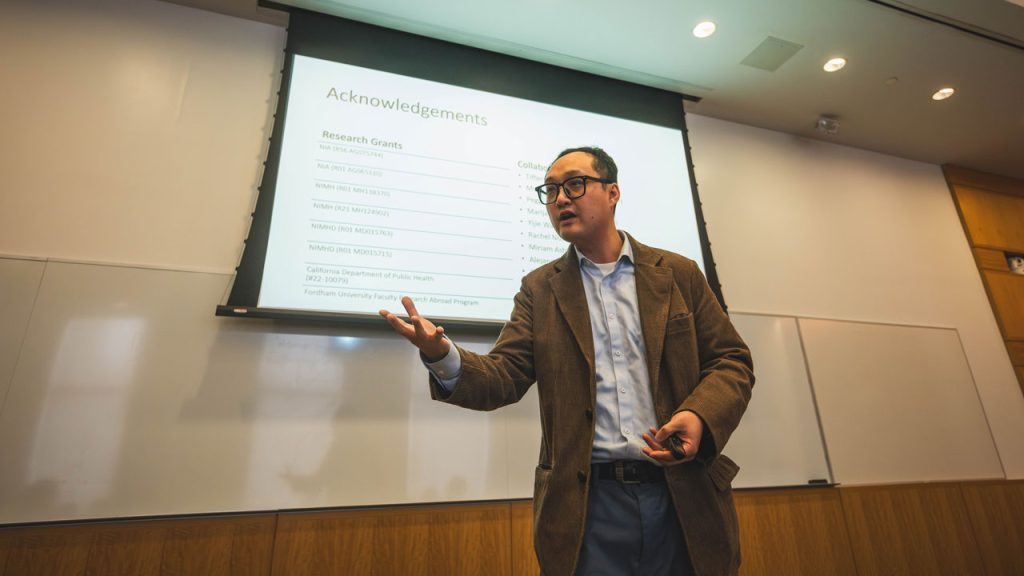Faculty and grad students presented seven novel uses of data science and AI at the Expanding Horizons workshop on March 31, an interdisciplinary event hosted by the Faculty of Arts and Sciences.
The uses for AI tools have evolved considerably since the event was first held in 2023, said economics professor Johanna Francis, Ph.D. She helped organize the workshop, held at Fordham Law School, with computer and information science professors Yijun Zhao, Ph.D., and Gary Weiss, Ph.D., as well as Stephanie Adomavicius, director of communications and events for the faculty of arts and sciences. “It was really quite interesting to see all these applications of AI,” said Francis.
The presentations spanned multiple fields, from economics to chemistry, and while not every study drew upon AI, its use dominated the discussion.
Fine-Tuning AI
One much-discussed topic was training or “fine-tuning” AI to improve its performance on a specific task—say, by feeding it complex data sets.
Computer science professor Mohamed Rahouti, Ph.D., tested two large language models (LLMs)—one that was custom trained, and one similar to ChatGPT—to see which was best at matching spoken commands for apps similar to Alexa and Siri. His team found that their custom model outperformed the out-of-the-box tool.
Chemistry professor Joshua Schrier, Ph.D., the Kim B. and Stephen E. Bepler Chair in Chemistry, shared his team’s experiments on tailoring ChatGPT for their research. By feeding ChatGPT their specific requirements, his team retrained the tool to predict whether a chemical compound could be made and what ingredients would be needed to make it.
His takeaway? Fine-tuning ChatGPT worked just as well, if not a little better, than another, custom-trained large language model that took longer to train.

Mapping Methane Levels in New York City
Other research presentations relied upon tools beyond AI to find patterns in data collection. Physics professor Stephen Holler, Ph.D., who studies air quality in New York City schools to raise awareness about climate change, discussed how he recently expanded his research by measuring methane across the city, using a sensor that detects natural gas leakage from stoves, buses, and landfills. The data showed consistently high methane levels in places like Arthur Avenue and the South Bronx, home to some of the city’s highest asthma rates. These methane emissions, Holler explained, can lead to the formation of ground-level ozone, which in turn harms the lungs and can trigger asthma.
Immigration + More Buildings = Safer City
Economics professor Troy Tassier, Ph.D., presented research about the root cause of infectious disease outbreaks in 19th-century New York City. Public officials at the time blamed immigrants for spreading cholera and other diseases, said Tassier. His data told a different story—that as housing laws improved, making buildings safer and better ventilated, death rates from infectious diseases went down in the city.
“All the building that happened due to immigration was making the city more safe,” he said. “So we can actually credit all of this immigration for creating a safer city.”
AI in the Classroom
Fernando Martínez-López, a graduate student in computer and information science, closed the event with a presentation of Maestro, the AI-powered tool his team developed, which could help teachers personalize instruction and save time—in theory.
“When we manage a class of 30 students, we would love to pay attention to all of the students, right?” he said. “However, there is a huge problem: we are only one professor or one teaching assistant.”
Maestro’s solution is to take a class outline or presentation slides and generate narrated, animated lessons that simulate the professor’s voice and offer a chatbot so students can pose their own questions.
Martínez-López then surveyed the students for feedback.
“They really liked it,” said Martínez-López, but the students said it couldn’t replace “real lectures.”
“This brings some hope,” he said. “Because we are not getting replaced—we are getting some help.”


